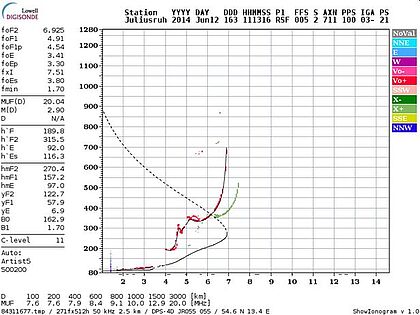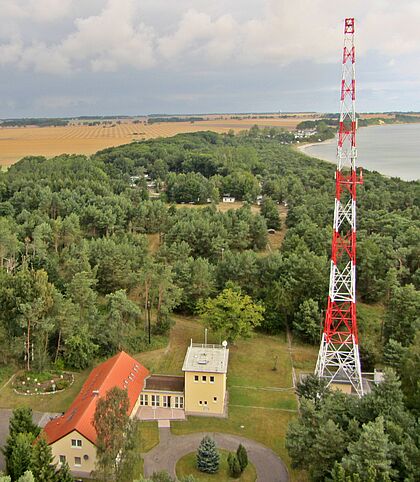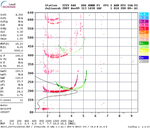The Ionosonde Juliusruh
The IAP field station at Juliusruh is well known for its more than 50 years of continuous ionosonde measurements of high quality. Since December 2011, we operate the latest version of so-called Digisondes, a DPS-4D. The DPS-4D model implements the latest capabilities of new digital RF circuitry and embedded computers. The “D” in the new model refers to the digital transmitters and receivers, which uses digital up- and down-converter IC chips. These technical and software innovations make possible to speed up and improve the quality of standard ionograms and save time for additional ionospheric measurements of interest. Thus, for example, drift measurements are now performed in the ionospheric E and F layer, as well as the typical ionogram.
Measuring principle - vertical sounding:
In the frequency range between 1 and 30 MHz short electromagnetic pulses are vertically transmitted into the ionosphere and are locally received after their ionospheric reflection. From the ionospheric echoes their amplitude, travelling time (virtual reflection height), Doppler shift, polarization, and angle of arrival are derived and presented in a so called ionogram in dependence on frequency.

Besides the scientific aspects of ionograms, the continuous measurements are used routinely to monitor and forecast the current ionospheric conditions. More recently such routine observations are complemented with forward scatter capabilities, allowing the reception of transmitted signals from other Digisondes located few hundreds of kms from Juliusruh. The ionosonde Juliusruh is part of the international Digisonde network GIRO (Global Ionospheric Radio Observatory) and the European ionosonde network DIAS (DIgital upper Atmosphere Server).
Technical specifications
| Frequency range | 1 to 15 MHz (0.5 to 30 MHz) |
| Peak power | max. 2x 150 W |
| Pulse width | 533µs (16x 33µs) |
| Transmitting antenna | 2 crossed rhombus antennas (70 m tower) |
| Receiving antenna | 4 crossed loop antennas |
| Height resolution | 1 - 2.5 km |
Publications
- M. A. Chernigovskaya, B. G. Shpynev, A. S. Yasyukevich, A. A. Mylnikova, D. S. Khabituev, P. Koucká Knivzová, D. Kouba, J. Mielich und A. Kozlovsky, Ionospheric variability over europe in winter from the ionosonde and gps/glonass data, Current problems in remote sensing of the Earth form space, 15, 295-307, doi:10.21046/2070-7401-2018-15-4-295-307, 2018.
- B. Reinisch, I. Galkin, A. Belehaki, V. Paznukhov, X. Huang, D. Altadill, D. Buresova, J. Mielich, T. Verhulst, S. Stankov, E. Blanch, D. Kouba, R. Hamel, A. Kozlov, I. Tsagouri, A. Mouzakis, M. Messerotti, M. Parkinson und M. Ishii, Pilot ionosonde network for identification of travelling ionospheric disturbances, Radio Sci., 53, 365-378, doi:10.1002/2017RS006263, 2018
- C. Borries, N. Jakowski, K. Kauristie, O. Amm, J. Mielich und D. Kouba, On the dynamics of large-scale traveling ionospheric disturbances over Europe on 20 November 2003, J. Geophys. Res., 122, 1199-1211, doi:10.1002/2016JA023050, 2017.
- N. Jakowski, M. M. Hoque, J. Mielich und C. Hall, Equivalent slab thickness of the ionosphere over Europe as an indicator of long-term temperature changes in the thermosphere, J. Atmos. Solar-Terr. Phys., 163, 91-102, doi:10.1016j.jastp.2017.04.008, 2017.














